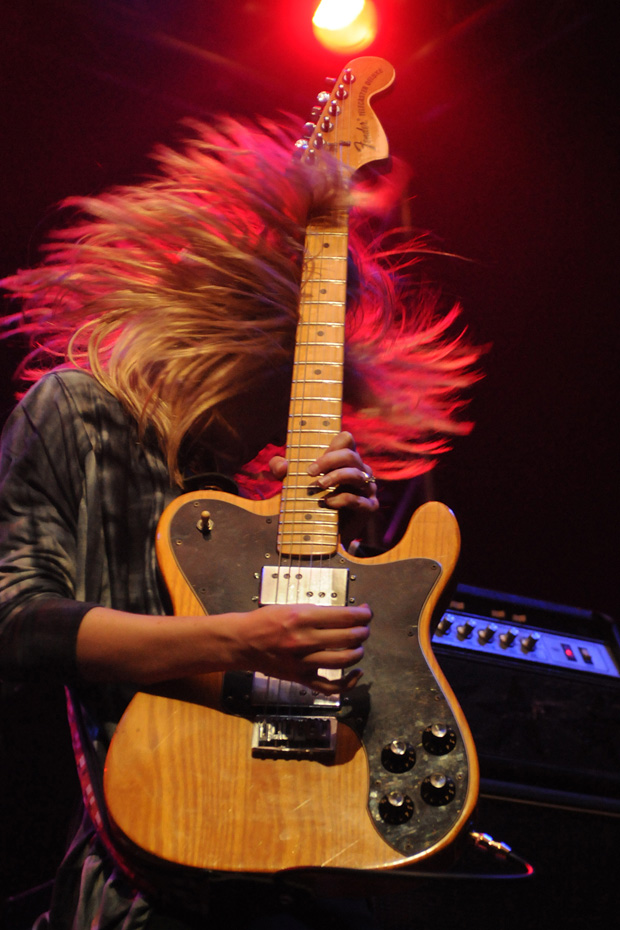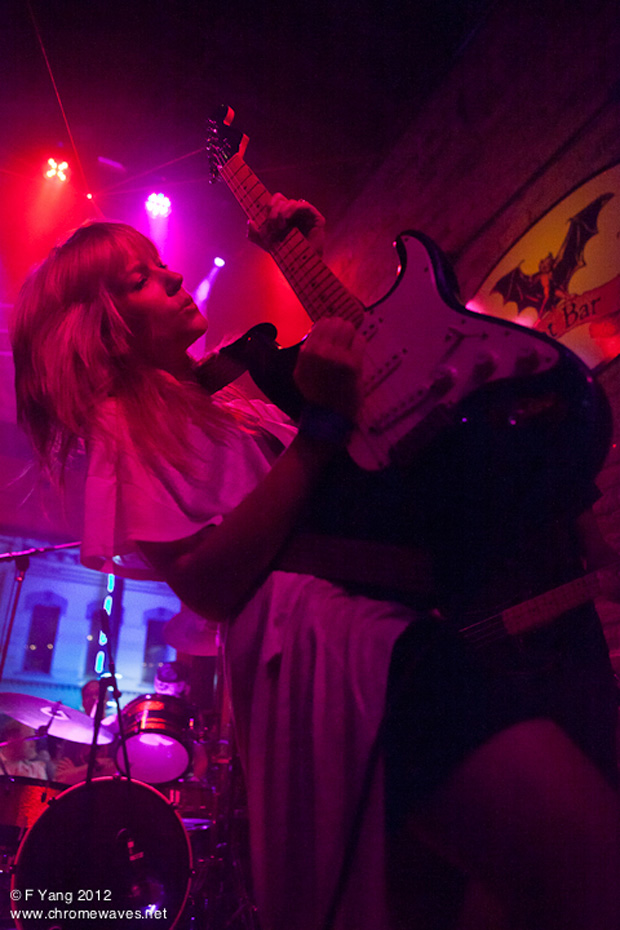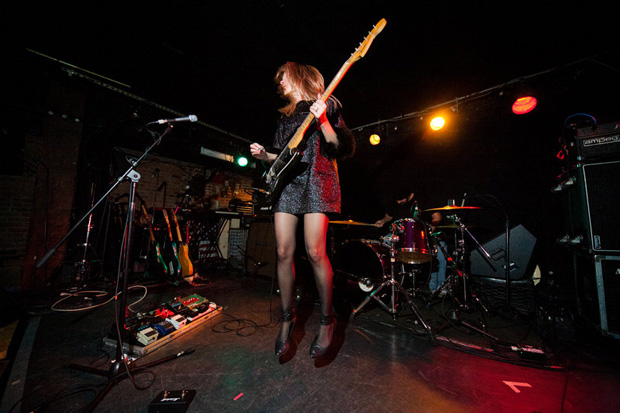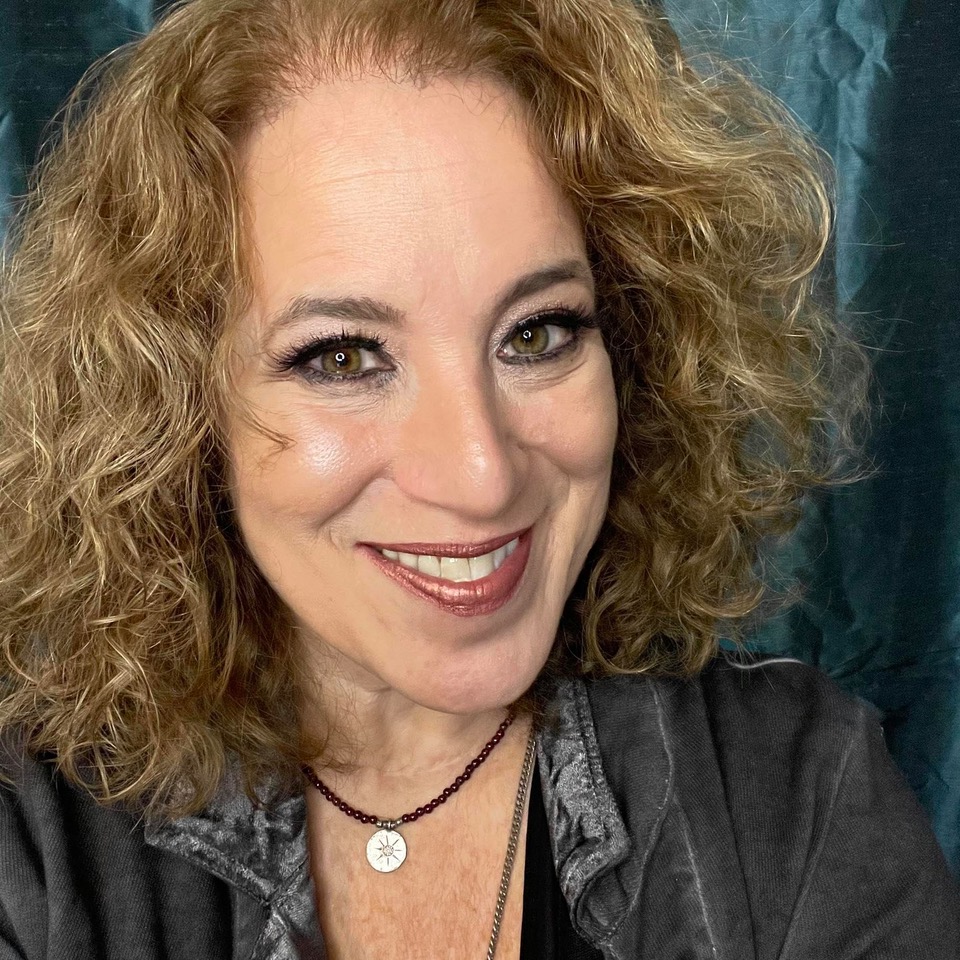Guitar Girl'd: Interview with Lauren Larson of Ume

At an unassuming 5-foot-2, Lauren Larson likes to startle. So don’t let her diminutive size fool you. Larson’s ferociously energetic guitar onslaught renders her a gargantuan guitar force. She’s just chock full of hair-flailing, guitar-wailing goodness.
Larson fronts Austin-based Ume (pronounced ooo-may), a power trio whose other two members are Larson’s husband, Eric, on bass and Rachel Furhrer on drums.
Ume’s 2009 Sunshower EP was exceptionally well received and was named one of the top albums of the year by Cincinnati WOXY radio. Ume stepped up in 2011 with the release of Phantoms, their first full-length album. Showcasing heavy riffs and driving beats, Phantoms' punky vibe is sharply contrasted by Larson’s sweetly ethereal vocal tone.
Live Larson commands the stage like a fury finally unleashed. It’s beauty meets the beast, all wrapped up into one petite powerhouse. Here Larson shares some thoughts on the road, her gear, and one of the benefits of being a foodie.
You’ve been touring in support of Phantoms. How’s that going?
Yeah, we’ve been touring heavily. Just got off the West Coast tour earlier this year with this band Cursive. In the meantime, we’ve been writing a lot of new material with our new drummer, Rachel Fuhrer. Gearing up for some summer festivals and a couple big tours this summer.
We’re about to do a co-headlining West Coast tour in June with The Life and Times. And then we just got chosen as the opener for The Toadies and Helmet national tour. That’s gonna be July through August.
All the latest guitar news, interviews, lessons, reviews, deals and more, direct to your inbox!
Do you have a favorite song that you like to play live from Phantoms?
No matter what song it is, I can find an emotional connection with it and let go. We’ve been having a lot of fun with the new material. One of the songs I like to play is “Dancing Blind” from Phantoms. It’s kind of a deeper track, it’s actually one of the earlier songs on there. And I wrote the guitar part on there. I changed to drop C on that one.
I have to ask you, I was on your site and I saw that whole thing with Anthony Bourdain and his show, No Reservations. So are you like a foodie? How did that come about?
We actually were the first band he’s eaten with that are true foodies! His people contacted us and said Anthony Bourdain was coming to Austin for SXSW, and they were picking some bands to be featured on his show. They came to one of our shows, and we didn’t know if Anthony Bourdain was even going to show up. The second song in, someone screamed “Anthony Bourdain!” He had come in and was sitting in the back. I think his quote was he had never seen that much rock in such a small room, and that if he’s smiling and his cameraman is smiling, then that’s a rare occasion! After he saw us live, we went to dinner with him, which was pretty awesome. We ate everything from chicken testicles to shrimp head.
That’s an adventure of its own, right?
It’s going to air in September, we’re going to be on No Reservations.
When you perform, you really seem sort of caught up in the moment. What goes through your mind or do you not think at all, you’re just there doing your thing?
In one sense, I’m completely focused. I don’t drink at all before I play. I’m using probably four or five guitars live, I use a lot of alternate-tunings live, and I have my pedals, incorporating my style of playing with my vocals, so I have to be focused. But in another sense, I really let go. I find when I hold the guitar it’s a chance to hold nothing back. I kind of have a sense empowerment that I don’t necessarily otherwise.
You've definitely got this special energy going on. Let’s take a step back and just talk to me a little bit about your background. What made you want to pick up the guitar in the first place?
I grew up, even as a young girl, always listening to my parents’ records. You know, Hendrix, Jefferson Airplane, Deep Purple. I was always into kind of a heavier sound, but I was playing piano and the oboe in school. But at the same time, doing routines to Guns N’ Roses and Prince.
So when I was around 12 or 13, I picked up my brother’s guitar. And at the time, my hands were too small to even do a power chord, but I opened up a Nirvana tab and the next thing I know I was sittin’ there playing “Come As You Are.” I was like, “Oh! This is easier than I thought!” So I stayed up all night with a tape of Nirvana and just decided to learn “Aneurysm” by ear. So I learned that song and from there, I just started teaching myself. Never took lessons.
I got in a band when I was 14. With that, it was just more of a punk rock, thrashy metal band. And I was 14 playing with some older guys called Twelve Blade and started playing live. I had my back to the audience; I was really shy playing. I still liked to be loud and play as much as possible. So that really helped me kind of a develop more of a metal style. I started doing a lot of drop D and experimenting with different tuning, especially because my hands are so small, I couldn’t learn the traditional chord structures.
That probably leads you to a different place when you’re writing your own stuff, too. Just thinking about things in a different way as you compose on guitar.
Oh, definitely. Now, I teach guitar with Girls Rock Camp often and I actually had to learn more of the traditional chord structures and theory. If anything, it’s very freeing ‘cause I don’t have a theoretical background with guitars. It’s very intuitive. It’s very instinctual for me. In that sense, I think it really helped me – playing by ear and by feeling. It helped me at least come up with my own unique style of creating riffs.
Why don’t we talk a little bit about your gear? You mentioned you use several guitars. Can you tell me what you’ve got going on there?
I have a mid-‘60s Fender Duo Sonic II, which is very nice, kind of a custom emerald green color on that. I have a ‘70s ash Mustang. I have a ‘70s Telecaster Deluxe, which is a real beast but that’s probably the one I play most live. I have dual humbuckers in that. My first guitar is an American Strat that I also play as well.
That’s a lot of Fenders you've got there.
Yeah, yeah. I love them. I also have various acoustic guitars. But those are the ones I play live. And they’re all different tunings live.
Right, that makes sense. What about amps and any other gear? What do you like to plug into?
I still play a Marshall JCM900, which was my first real amp. I usually have two cabinets on-stage in stereo, a Mesa Boogie cab and then the Marshall cab on the other side. I use mainly the distortion from that amp, and the built-in reverb. I also use an Electro-Harmonix POG pedal, a lot of the time. I do a lot of arpeggiated and single-note type riffs, so that adds a lot of thickness to it,‘cause I don’t do a lot of traditional chords. And then a couple delay pedals, as well.
Your voice has this sweetness to it, but it’s the sweetness combined with the overdriven guitar, that’s just a really cool combination of sound.
Oh, thank you! For me, I always identified as a guitar player, far more than a vocalist. When we first started Ume, I was terrified to sing. I didn’t know I was going to be the singer at all in the band. No one else was willing to do it, so finally I just started screaming into the microphone. I show that technique while I’m helping girls with Girls Rock camp. Early on I had much more of a raw sound, a much more guttural vocal technique. But I’ve grown as a musician, and have been finding my voice and trying different things. I think vocals are still kind of ... it’s still an insecurity for me, strangely.
Tell me more about your involvement with the Girls Rock Camp.
Girls Rock Camp is a nonprofit organization that seeks to empower young girls through music. I teach guitar with that and I’m also a band coach. Basically, girls, many of them who have never touched an instrument before in their lives, get together for a week, form a band, write their own totally original material, and perform it for around 600 people.
Growing up and playing live since I was 14, I really didn’t have a lot of role models. And even now people are still surprised to see that I’m in a band. They expect me to be just the singer. I’ve even gotten, “Oh are you the dancer in the band?” or “Are you just the merch girl?” Having those experiences my whole life has really made me want to encourage girls to get up there, find their voice, express themselves through music, and hopefully they won’t have to get the same rude comments or surprise when they take the stage.
Yeah, I think of a lot of women players have had similar experiences.
There are so many talented female musicians out there now. Even when I was younger, I wanted to be respected as a guitar player, not an anomaly, or “Oh, you’re a girl.” I kind of always wanted to transcend the gender-line there. But yeah, it’s still surprising, especially as a guitarist. People are still very surprised to see a woman guitarist that actually rocks out on stage. They expect, “Oh, she’s going to be a folk singer” or “She’s setting up those guitars for her boyfriend.” I’ve even had people tell me how to set up my pedals on stage. It’s silly, but I think we’re moving beyond that. That’s one of my life goals, to get it where no one’s going to be surprised to see a woman on-stage while rocking out.
Do you have any advice for other women that are hoping to take this path of playing guitar, performing, and rocking out?
For me, one of cool things about guitar is there are no rules with it. I totally kind of used this instrument to find my own voice. One of the techniques I use when I’m working with a girl at the camp is to come up with your own chord, come up with something that you just like the way it sounds. So that’s the first thing, to not think you have to sit there with some technical book and learn everything just right because it’s rock n’ roll, ultimately. I think there’s a freedom that people need to tap into. And just have fun! When else can you have a chance to totally hold nothing back and scream and have fun?
Find out what’s next for Larsen and UME at umemusic.com.
Check out the official video of Lauren and Ume’s song “Captive.” Catchy!
In the photo gallery below, Larson is playing several guitars. Here she shares her tunings and which songs she plays on each:
Fender Duo-Sonic II
Tuning: FCFA#CE
Played on "The Conductor," "Rubicon," "Sunshower"
Fender Mustang
Tuning: FCFA#BE
Played on "The Push"
Fender Telecaster Deluxe
Tuning: Drop D and Standard
Played on "Burst," "Run Wild," "Black Stone," most unreleased material
Fender American Strat
Tuning: CGDGAE
Played on "Captive," "Hurricane II," "Dancing Blind"












Laura B. Whitmore is a music industry marketing veteran, music journalist and editor, writing for Parade.com, Guitar World, and others. She has interviewed hundreds of musicians and hosts the She Rocks Podcast. As the founder of the Women’s International Music Network, she advocates for women in the music industry and produces the annual She Rocks Awards. She is the Senior Vice President of Marketing for Positive Grid, making the world safe for guitar exploration everywhere! A guitarist and singer/songwriter, Laura is currently co-writing an album of pop songs that empower and energize girls.

